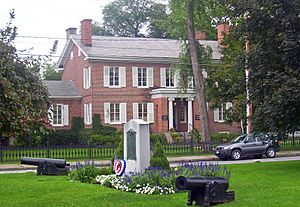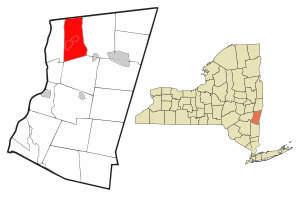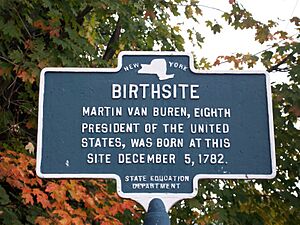Kinderhook, New York facts for kids
Quick facts for kids
Kinderhook, New York
|
|
|---|---|

Main square in Kinderhook
|
|

Location of Kinderhook, New York
|
|
| Country | United States |
| State | New York |
| County | Columbia |
| Settled | 1750 |
| Established | 1788 |
| Government | |
| • Type | Town Council |
| Area | |
| • Total | 32.41 sq mi (83.95 km2) |
| • Land | 31.81 sq mi (82.38 km2) |
| • Water | 0.61 sq mi (1.57 km2) |
| Elevation | 239 ft (73 m) |
| Population
(2020)
|
|
| • Total | 8,330 |
| • Density | 257.02/sq mi (99.23/km2) |
| Time zone | UTC−5 (Eastern (EST)) |
| • Summer (DST) | UTC−4 (EDT) |
| ZIP Code |
12106
|
| Area code(s) | 518 |
| FIPS code | 36-021-39573 |
| GNIS feature ID | 0979116 |
Kinderhook is a town in the northern part of Columbia County, New York, in the United States. In 2020, about 8,330 people lived there, making it the most populated town in Columbia County.
The name "Kinderhook" comes from the Dutch language. It means "Children's Corner" (Kinderhoek). This name might have come from Henry Hudson's visit in 1609. He saw many Native American children gathered on the riverbank. The Dutch word kind means "child," and hoek means "corner." So, it could mean a bend in the river where children were seen.
The eighth president of the United States, Martin Van Buren, was born in Kinderhook. He also retired there after his time as president.
The town of Kinderhook has two villages. One is also called Kinderhook, and the other is Valatie. There is also a small community called Niverville near Kinderhook Lake.
Contents
History of Kinderhook
In 1609, explorer Henry Hudson sailed up the Hudson River and reached the area of Kinderhook. He named the spot "Kinderhoek." This name, meaning "the children's corner" in Dutch, is believed to have been given because many Native American children gathered to watch his ship, the Half Moon, sail by.
The Dutch settlers had different interactions with the local Mohican natives. Sometimes they traded peacefully, and other times there were small fights. As the Dutch tried to settle the area, more conflicts happened.
Kinderhook was settled before 1651. It officially became a town in 1788. Over the years, parts of Kinderhook were used to create other towns, like Chatham in 1775, Ghent in 1818, and Stuyvesant in 1823.
Geography and Nature
Kinderhook covers about 83.9 square kilometers (32.4 square miles). Most of this area is land, but about 1.6 square kilometers (0.6 square miles) is water. This includes Kinderhook Lake, Kinderhook Creek, and the waterfalls in Valatie.
The northern border of the town is also the border of Rensselaer County.
Kinderhook Creek is an important stream that flows through the town. It goes southwest towards the Hudson River. Major roads like U.S. Route 9 and New York State Route 9H also pass through Kinderhook.
Arts and Culture in Kinderhook
Kinderhook is home to several interesting historical and cultural sites.
Martin Van Buren's Home
President Martin Van Buren's retirement home, called Lindenwald, is located in Kinderhook. This historic site is a great place to learn about his life and the history of the area.
Washington Irving and "The Legend of Sleepy Hollow"
The Luykas Van Alen House (built around 1737) is a Dutch Colonial home in Kinderhook. It is believed to have inspired author Washington Irving for the "Van Tassel family" farm in his famous story "The Legend of Sleepy Hollow". Irving was a friend of Martin Van Buren and often visited the area.
Next to the Van Alen House is the 19th-century Ichabod Crane Schoolhouse. This schoolhouse is named after the character Ichabod Crane from Irving's story. The character was based on a real Kinderhook schoolteacher named Jesse Merwin.
Historical Society and Museums
The Columbia County Historical Society has its main office in Kinderhook. They manage four historic properties:
- The 1737 Luykas Van Alen House.
- The 1850 Ichabod Crane Schoolhouse.
- The 1819 James Vanderpoel 'House of History'.
- The 1915 CCHS Museum & Library building.
These places help tell the story of Columbia County's past. The James Vanderpoel House, also known as "The House of History," is a beautiful example of Federal architecture from around 1819.
Art and Events
The former Martin Van Buren Public School on Broad Street now houses "The School." This is an international gallery that shows modern fine art.
The Olde Kinderhook Fair, also called the Kindercrafters Fair, is an annual event. It's an arts and crafts fair held in the Kinderhook Village Square. It often includes other activities like book sales and live music.
Population Information
| Historical population | |||
|---|---|---|---|
| Census | Pop. | %± | |
| 1820 | 3,963 | — | |
| 1830 | 2,706 | −31.7% | |
| 1840 | 3,512 | 29.8% | |
| 1850 | 3,970 | 13.0% | |
| 1860 | 4,331 | 9.1% | |
| 1870 | 4,055 | −6.4% | |
| 1880 | 4,200 | 3.6% | |
| 1890 | 3,709 | −11.7% | |
| 1900 | 3,333 | −10.1% | |
| 1910 | 2,947 | −11.6% | |
| 1920 | 2,935 | −0.4% | |
| 1930 | 3,104 | 5.8% | |
| 1940 | 3,094 | −0.3% | |
| 1950 | 3,284 | 6.1% | |
| 1960 | 4,185 | 27.4% | |
| 1970 | 5,688 | 35.9% | |
| 1980 | 7,674 | 34.9% | |
| 1990 | 8,112 | 5.7% | |
| 2000 | 8,300 | 2.3% | |
| 2010 | 8,498 | 2.4% | |
| 2020 | 8,330 | −2.0% | |
| U.S. Decennial Census | |||
As of the 2020 census, Kinderhook had a population of 8,330 people. The population has grown quite a bit since the 1800s. In 2000, the average age in the town was 41 years old.
Notable People from Kinderhook
Many interesting people have connections to Kinderhook:
- John Faso – A former U.S. representative.
- Chris Gibson – Another former U.S. representative.
- William S. Groesbeck – A U.S. representative.
- Washington Irving – The famous author, who lived in Kinderhook for a short time. He wrote parts of his book A History of New-York here.
- Jennie Jerome – The mother of Winston Churchill, who lived in Kinderhook.
- Jesse Merwin – A Kinderhook schoolteacher who inspired the character Ichabod Crane.
- John Woodward Philip – A naval officer during the Civil War and Spanish–American War.
- Donald L. Rutherford – The 23rd Chief of Chaplains of the United States Army.
- Nicholas Sickles – A U.S. representative.
- John Evert Van Alen – A U.S. representative.
- Martin Van Buren – The eighth president of the United States, born and lived in Kinderhook. His nickname "Old Kinderhook" might be where the word "OK" comes from!
- Cornelius P. Van Ness – The 10th governor of Vermont.
- Peter Van Schaack – A lawyer and British Loyalist during the American Revolution.
Communities and Locations in the Town
- Kinderhook – A village located on U.S. Route 9.
- Kinderhook Lake – A lake on the northeastern border of the town.
- Kinderhook Memorial Library – A public library serving the village of Kinderhook.
- Knickerbocker Lake – A small lake in the northern part of the town.
- Lindenwald (Martin Van Buren National Historic Site) – The last home of President Martin Van Buren.
- Niverville – A small community in the northeastern part of the town, near Kinderhook Lake.
- Valatie – A village located in the center of the town.
- Valatie Colony – A community north of Valatie village.
Fun Facts About Kinderhook
Kinderhook in Movies and TV
- In the movie Silver Linings Playbook (2012), a character explains that the word "OK" comes from "Old Kinderhook."
- Parts of the movie Meskada (2009) were filmed in Valatie.
- The Cake Eaters (2006) was filmed in Kinderhook and nearby towns.
- A scene from the movie The Age of Innocence (1993) was filmed at the Van Alen House.
- In the TV show The Sopranos, a character owns a farm in Kinderhook.
Music Inspired by Kinderhook
- The band Rasputina has an album called Sister Kinderhook. It's about the Dutch history of the town and other old Dutch settlements in New York.
Other Interesting Facts
- One popular idea for the origin of the word "okay" is that it came from "Old Kinderhook," which was a nickname for President Martin Van Buren during his election campaign.
- The children of the famous American actor Sidney Poitier went to school in Kinderhook.
Images for kids
See also
 In Spanish: Kinderhook (pueblo) para niños
In Spanish: Kinderhook (pueblo) para niños





